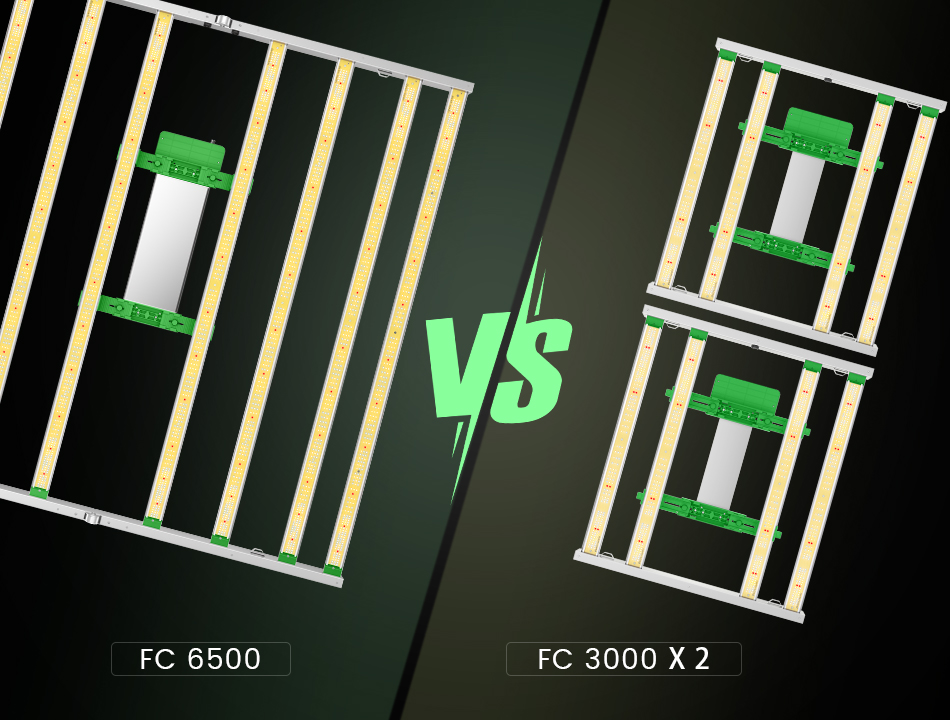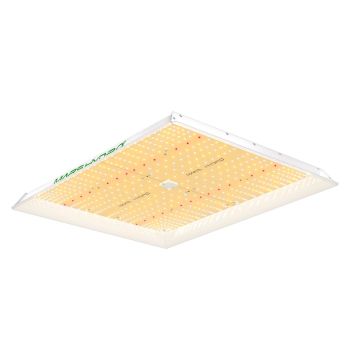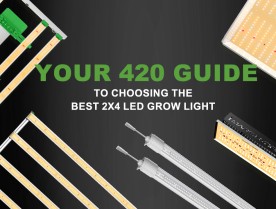
When it comes to indoor growing, lighting plays a vital role in ensuring the success and health of your plants. Among the various considerations, one important decision revolves around whether to use multiple small-size grow lights or a single large-size grow light. This choice can significantly impact the growth, yield, and overall performance of your indoor garden. The question becomes: Which option is truly the best for indoor growing?
In this blog post, we delve into the debate between multiple grow lights and a single grow light to discover the optimal solution for your indoor gardening needs.
Benefits of Using Just One Large-Sized LED Grow Light for Indoor Plants

Usually, growers will choose to buy a single grow light with the largest coverage according to the size of their planting space to ensure that the light can be evenly distributed. And with just a single light fixture, you can easily install and position it, reducing the complexity of managing multiple lights, power supplies, and suspension systems. This saves time and effort during initial setup and ongoing maintenance.
However, for growers who have higher growing requirements and need to make targeted lighting adjustments to plants, or grow different plants (plants with different light requirements) in the same grow space, choosing just one grow light may not be able to meet their planting requirements. So in this case, installing several small-sized lights became their first consideration. What are the specific benefits of doing this, and what do we need to pay attention to, please continue to read!
Benefits of Using Multiple Small-Sized LED Grow Lights for Growing Indoors

Optimizing Light Distribution and Leading to More Uniform PPFD
Using multiple grow lights can help optimize light distribution, leading to more uniform PPFD (Photosynthetic Photon Flux Density) and improved PPE (Photosynthetic Photon Efficiency) across the growing area. The intensity of light decreases as plants move away from the center of the light source, creating a gradient where plants closer to the light receive more light while those farther away receive less.
That is to say, the closer to the center of the light source, the larger the PPFD value, and the farther away from the center, the smaller the PPFD value. Taking Mars Hydro FC-E6500 LED grow light as an example, in a planting space of 4x4FT, the PPFD value of the light source center is close to 1500umol/m²/s at a distance of 8'' from the light source to the plant, and the PPFD value of other areas within the coverage area decreases with the distance from the center. Although the PPFD value at the coverage area corner is still high, there is still a certain gap compared with its at the center of the light source.
When multiple small grow lights are used, they can be strategically positioned to evenly distribute light throughout the growing area. By spacing the lights appropriately, each plant receives light from multiple angles, minimizing shading and providing more uniform light coverage. The combination of multiple lights ensures that plants located at different positions within the growing area receive a more balanced and consistent PPFD. And this promotes even growth and reduces the risk of light stress or insufficient light reaching certain parts of the plants.
Easily Customize Light for Different Plants
Different plants have different requirements for spectrum and light intensity according to their growth stages, varieties and specific needs. By using multiple small-sized plant lights, growers can flexibly make targeted lighting adjustments according to the specific needs of different plants. If certain plants require more or less light at certain stages of growth, growers can adjust the position, intensity or spectrum of individual lights to meet those requirements. This level of customization ensures that each plant receives optimal lighting conditions throughout its growth cycle. Beyond that, when using multiple grow lights, growers can group together indoor plants with similar light requirements. They can then customize the lighting settings for each group of plants, optimizing the growing environment for each specific plant type.
Example: Let's say a grower is cultivating a mix of seedlings, mature indoor plants, and indoor plants in the flowering stage. Seedlings require lower light intensity to prevent burning, while mature plants need higher light levels for optimal growth. Additionally, indoor plants in the flowering stage may benefit from increased red light to promote blooming. By using multiple indoor grow lights, the grower can adjust the intensity, spectrum, or position of each light to meet the specific requirements of each growth stage.
Reducing the Risk of Crop Loss
One of the key advantages of using multiple grow lights is the built-in redundancy it provides. If one light were to fail or malfunction, the other lights can continue providing illumination to the plants. This redundancy minimizes the risk of sudden and complete darkness, which could be detrimental to plant growth. By having backup lighting sources, growers can mitigate the potential loss of crops due to unexpected equipment failure.
In addition, if certain plants show signs of stress or inadequate growth, growers can investigate and identify potential issues with individual lights. By pinpointing and addressing specific lighting problems promptly, they can prevent further crop loss and ensure the overall health of the garden.
Multiple Small Grow Lights Can Be More Cost-Effective
In some cases, multiple small grow lights can be more energy-efficient than a single big grow light. This is because smaller lights provide the flexibility to adjust the lighting intensity according to the specific needs of different indoor plants or growth stages. By using only the necessary amount of light, you can optimize energy consumption and reduce operating costs over time.
Help Dissipate Heat More Effectively
Multiple grow lights distribute heat more evenly throughout the growing area compared to a single large grow light. Instead of having one concentrated heat source, the heat generated by each individual light is dispersed across a wider area. And excessive heat can cause stress to plants, leading to reduced growth, wilting, or even plant damage. By dispersing heat more effectively, multiple grow lights help maintain a more stable and suitable temperature range for plant growth. This reduces the risk of heat stress and allows plants to thrive in a more comfortable environment.
It's worth noting that while multiple grow lights can help dissipate heat more effectively, it is still important to monitor and manage the overall temperature and humidity levels in your indoor growing space. Proper ventilation, air circulation, and temperature control measures should be implemented to create an optimal environment for plant growth while ensuring efficient heat dissipation.
How to Decide Whether to Use One Single Grow Light or Multiple Grow Lights?

Deciding whether to use one single light or multiple grow lights in indoor growing requires careful consideration of several factors. Here's a step-by-step guide to help you make an informed decision:
Assess Your Growing Area: Evaluate the size and layout of your indoor growing space and the number of your indoor plants. Determine the dimensions and shape of the area you need to cover with grow lights.
Taking a 5x5 planting area as an example, you can choose to install a Mars Hydro large-size light like FC6500/FC-E6500/FC8000/FC-E8000 to cover the planting area perfectly. And if you have two medium-to-large plants in the planting area, for better coverage of your plants, you can customize the lighting scheme yourself, such as installing two FC3000/FC-E3000/TSW2000 LED grow lights for growing indoors side by side or diagonally.
Customize the corresponding lighting according to the placement position and number of medium-and-large indoor plants, so that each plant can receive the most uniform PPFD to the greatest extent, and this proper lighting scheme has become the most ideal choice.
Understand Plant Requirements: Research the specific light requirements of the indoor plants you are growing. Consider factors such as light intensity, spectrum, and photoperiod preferences. Determine if the indoor plants have uniform light requirements or if they vary based on growth stage or species.
Flexibility vs. Simplicity: Assess the level of flexibility you require in your lighting setup. Multiple grow lights offer more flexibility in positioning, customization, and light distribution. On the other hand, a single light provides simplicity and ease of setup and maintenance.
Energy Efficiency: Compare the energy efficiency of the lighting options you are considering. Look for lights with high efficacy ratings (measured in micromoles per joule, µmol/J) to ensure efficient energy usage.
Redundancy and Risk Mitigation: Consider the importance of having a backup lighting system in case of light failure. And assess the level of risk tolerance you have for potential crop loss due to lighting issues.
Consider Future Expansion: Evaluate whether you anticipate expanding your indoor growing operation in the future. And assess the scalability of the lighting options you are considering and how well they can accommodate future growth.
Final Thoughts
It can be seen that in the same planting space, choosing a large-size grow light or multiple small-size grow lights depends on many factors. Choosing multiple grow lights or just one grow light, there is no absolute answer. You should make decision for light using according to the situation of your own indoor planting area.
And for growers with medium-to-large indoor plants indoors, a smaller-size-light may be the best choice. Mars Hydro FC3000, FC-E3000, and TSW2000 LED grow lights are popular among customers, have won a good reputation, and they can perfectly provide the most suitable artificial light for a single medium-to-large plant.
If you want to customize the lighting scheme yourself and don't know how to choose the combination of the LED grow lights, please feel free to contact us, we will provide you with the most complete suggestions.











